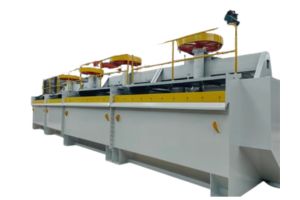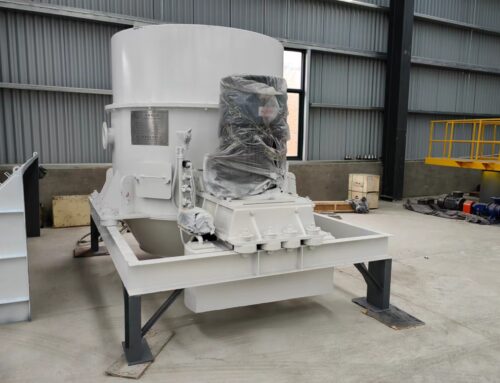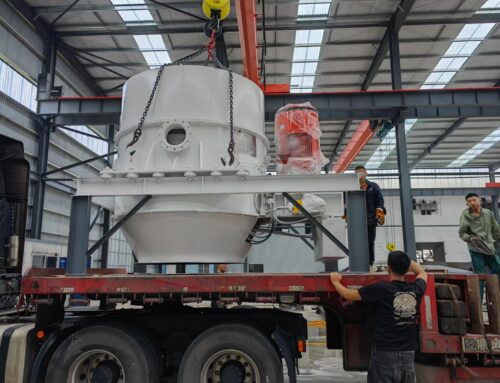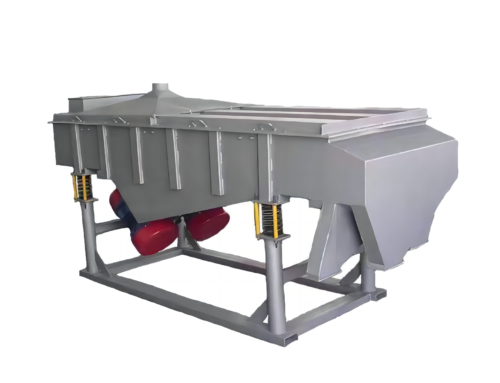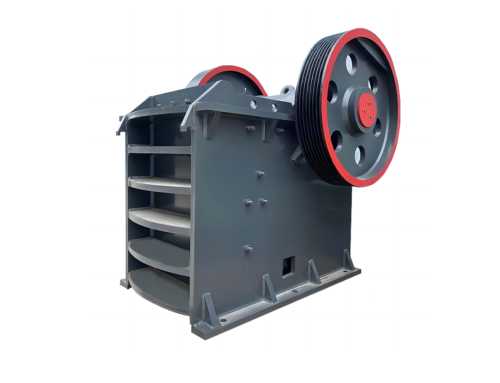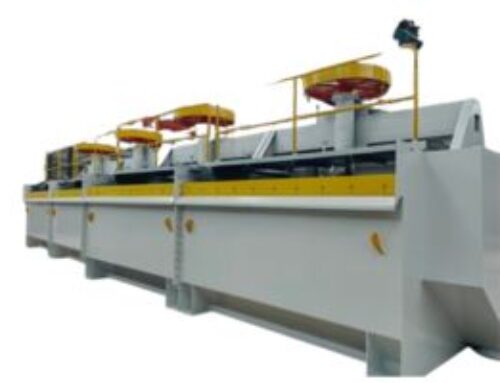As an important mineral processing equipment, flotation machine plays a key role in mineral processing. However, in the process of use, the flotation machine will also appear some common problems, affecting the production efficiency and product quality. The following is to discuss how to solve the common problems of flotation machine.
一. The flotation machine foam abnormal
1.Too much or too little foam
Reason: improper addition of chemicals, inappropriate air intake, pulp concentration is unreasonable.
Solution:
Adjust the additive amount of chemicals. According to the nature of the ore and the requirements of flotation process, reasonably control the dosage of frothing agent and trapping agent. The best dosage of chemicals can be determined through laboratory tests and on-site debugging.
Adjust the air intake. Check the air inlet system of the flotation machine to ensure that the air can enter the flotation tank evenly. The air intake can be controlled by adjusting the air intake valve or the speed of the blower.
Optimise slurry concentration. Adjust the slurry concentration according to different ore types and flotation requirements. Generally speaking, too high a slurry concentration will result in too much froth, while too low a slurry concentration will result in too little froth. You can adjust the slurry concentration by adding water or adding thickener.
2.Sticky foam
Reason: too high content of ore sludge, improper selection of chemicals, too long flotation time, etc.
Solution:
Remove the mineral mud. Use desliming process, such as cyclone classification, thickener sedimentation, etc., to remove the fine mud in the slurry. You can also add dispersant to reduce the viscosity of the sludge.
Reasonable selection of chemicals. According to the nature of the ore, choose suitable foaming agent and trapping agent. Avoid the use of viscous agents.
Control the flotation time. According to the floatability of the ore and flotation requirements, reasonably control the flotation time. Avoid too long flotation time, resulting in sticky foam.
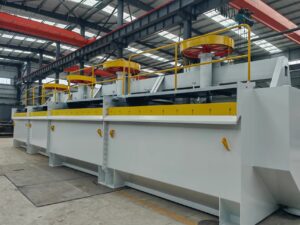
二. Uneven mixing of flotation machine
Reason:failure of agitator, inappropriate motor speed, too high or too low concentration of slurry, etc.
Solution:Check the agitator. Regularly check the blades, shafts and bearings of the agitator to ensure its normal operation. If the agitator is found to be damaged, it should be replaced in time.
Adjust the motor speed. According to the specifications of the flotation machine and the nature of the ore slurry, adjust the rotational speed of the motor to ensure the stirring effect.
Optimise the slurry concentration. Control the concentration of the slurry in the appropriate range to avoid too high or too low a concentration of slurry to affect the stirring effect.
三. The flotation machine level is not stable
Reason: unstable amount of ore feeding, inappropriate amount of ore discharge, damage to the internal structure of the flotation machine and so on.
Solution:Stabilise the amount of ore feeding. Adopt automatic ore feeding system to ensure that the amount of ore feeding is uniform and stable. You can also control the feeding volume by adjusting the parameters of the feeding equipment, such as the feeding speed and the feeding particle size.
Adjust the discharge volume. According to the liquid level and foam condition of the flotation machine, reasonably adjust the opening of the discharge valve to control the discharge volume.
Check the internal structure of the flotation machine. Regularly check the internal structure of the flotation machine, such as the tank body, impeller, stator and other parts, to ensure that they are intact. If damage is found, it should be repaired or replaced in time.
四. The flotation machine energy consumption is too high
Reason:excessive motor power, low efficiency of the flotation machine, improper operation, etc.
Solution:Optimise motor selection. According to the specifications and process requirements of the flotation machine, select the appropriate power motor. Avoid excessive motor power, resulting in energy waste.
Improve the efficiency of the flotation machine. Improve the efficiency of the flotation machine by improving the structural design of the flotation machine and optimizing the flotation process parameters. For example, adopting new impeller and stator structure, optimising the pharmaceutical system, increasing the amount of air filling, etc.
Standardise the operation. Strengthen the training of the operators and improve the operating skills. Operate in strict accordance with the operating procedures to avoid excessive energy consumption due to improper operation.
五. Flotation machine maintenance
1.Regular inspection
Regularly conduct a comprehensive inspection of the flotation machine, including mechanical parts, electrical system, lubrication system, etc.. Timely detection and treatment of problems to avoid the expansion of the fault.
2.Cleaning and maintenance
Regularly clean the accumulated ore and debris inside the flotation machine to keep the flotation machine clean. At the same time, the surface of the flotation machine is cleaned and anticorrosion treatment to extend the service life of the equipment.
3.Lubrication Maintenance
Regularly lubricate and maintain the bearings, gears and other parts of the flotation machine. Choose suitable lubricants and refill them according to the specified lubrication cycle.
4.Spare parts management
Establish a spare parts management system and reserve necessary spare parts. Ensure that when the equipment fails, the spare parts can be replaced in time to reduce downtime.
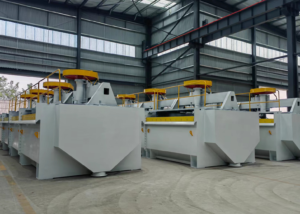
Flotation machine tank wear is a more common problem, here are some ways to deal with it:
一. Preventive Measures
1.Reasonable selection of materials
In the design and manufacturing stage of the flotation machine tank body, choose materials with good wear resistance. For example, high hardness alloy steel, rubber lining or polyurethane can be used to make the tank body, which have good wear resistance and can prolong the service life of the tank body.
According to the nature of the ore to be treated and the process requirements, choose the appropriate material. For higher hardness and corrosive ores, more wear-resistant and corrosion-resistant materials should be selected.
2.Optimise process parameters
Control the slurry flow rate. Excessive slurry flow rate will aggravate the wear of the tank body. By adjusting the feed volume, flotation machine impeller speed and other parameters, so that the slurry in the tank body to maintain a reasonable flow rate, reduce the wear of the tank body scouring. Control slurry concentration. Appropriately reducing the slurry concentration can reduce the collision and friction between particles, thus reducing the wear of the tank body. At the same time, lower slurry concentration is also conducive to improving the flotation effect.
Reasonable addition of chemicals. Some chemicals can improve the fluidity and stability of the slurry and reduce the impact and wear of particles on the tank body. For example, adding dispersant can reduce the viscosity of the slurry, reduce the agglomeration of particles, and thus reduce wear.
3.Strengthen operation management
Keep the equipment running stably. Avoid starting and stopping the flotation machine frequently to reduce the damage caused by equipment vibration and impact on the tank body. At the same time, make sure that the flotation machine is firmly installed to avoid increased wear of the tank due to equipment shaking.
Clean the tank body regularly. Remove the accumulated ore and debris in the tank body in time to prevent these substances from causing wear and tear on the tank body. At the same time, cleaning the tank is also conducive to improving the flotation effect.
Strengthen the maintenance of equipment. Regularly inspect and maintain the flotation machine, and timely find and deal with the wear and tear of the tank body. For example, make up welding or replace the liner plate for the parts with serious wear.
二. The treatment method after wear
1.Repair by patch welding
When the groove body has partial wear, it can be repaired by the method of patch welding. First of all, clean up the worn parts, remove rust, oil and other impurities. Then, select the appropriate welding material and welding process, the wear parts for patch welding. When replacing the welding, attention should be paid to controlling the welding temperature and welding speed to avoid deformation or cracking of the groove body due to overheating.
For the more serious parts of the wear, you can use multi-layer multi-pass welding method to repair, in order to increase the welding strength and wear resistance. After the repair welding is completed, the welded parts should be polished and examined by flaw detection to ensure the welding quality.
2.Replacement of liner
If the wear and tear of the tank body is more serious, the replacement welding can not meet the requirements, you can consider replacing the liner. The liner is a kind of wear-resistant material installed on the inner wall of the tank body, which can effectively protect the tank body from abrasion.
Choose suitable liner material and specifications. According to the nature of the ore to be processed and the process requirements, choose the liner material with good wear resistance and easy installation. At the same time, make sure that the specification of the liner plate matches the trough body to ensure the firmness and sealing of the installation.
When replacing the liner, the old liner should be dismantled first, and the accumulated ore and debris inside the trough body should be cleaned up. Then, install the new liner on the inner wall of the tank body according to the installation requirements, and carry out the fixing and sealing treatment.
3.Surface treatment
For the slightly worn trough body, surface treatment can be used to repair. For example, spray welding, thermal spraying and other technologies can be used to form a layer of wear-resistant coating on the surface of the groove body to improve the wear resistance of the groove body.
Selection of appropriate surface treatment technology and materials. According to the material and wear of the groove body, select the appropriate surface treatment technology and material. For example, tungsten carbide spray welding technology can be used for alloy steel tanks; for rubber lined tanks, polyurethane spraying technology can be used.
After the surface treatment is completed, the treated parts should be inspected and tested to ensure that the quality and performance of the coating meet the requirements.
In short, for the flotation machine tank wear problem, should take prevention as the main, prevention and control of the combination of methods. Through reasonable selection of materials, optimisation of process parameters, strengthening of operational management and other measures, the wear of the tank body can be effectively reduced. When the wear of the tank body occurs, appropriate treatment methods should be selected according to the wear situation, and timely repair should be carried out to ensure the normal operation of the flotation machine.
Solving the common problems of the flotation machine needs to start from many aspects, including optimising process parameters, strengthening equipment maintenance, improving operator skills and so on. Only by comprehensively considering these factors can we ensure the normal operation of the flotation machine and improve production efficiency and product quality.

